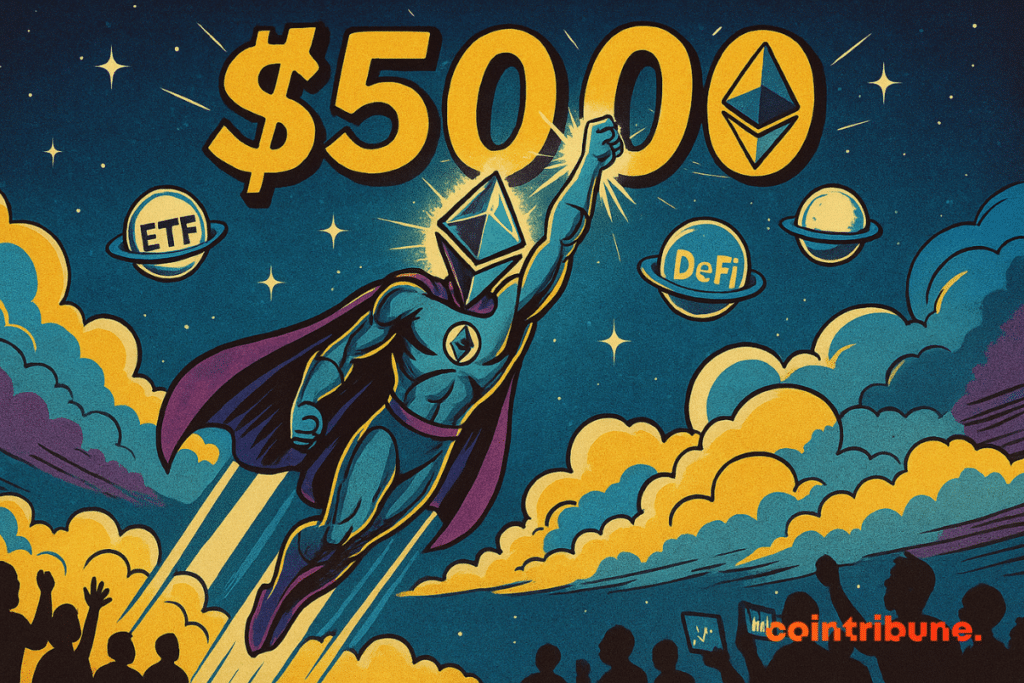9h05 ▪
5
min read ▪ by
While Ethereum surged by 43.6 % in one week, reaching 2,600 dollars, the prospect of a return to 5,000 dollars reappears in discussions. This threshold, long considered out of reach, is once again part of analysts’ scenarios. For some, this surge goes beyond a simple speculative spike and could mark the starting point of a deeper bullish phase, driven by technical fundamentals and a rapidly evolving adoption.


In Brief
- Ethereum experienced a spectacular 43.6 % increase in one week, reaching $2,600, sparking renewed speculation of a return to $5,000.
- Despite this rise, institutional interest remains low, as evidenced by $4 million withdrawals from ETH ETFs in the United States.
- The Pectra upgrade enhanced the network’s scalability, leading to a sharp increase in activity on Layer 2 solutions.
- Ethereum could become deflationary again if onchain activity increases, a key condition to sustainably support its price.
The institutional hypothesis : between current skepticism and regulatory expectations
The price of Ethereum saw a surge of +43.6 % between May 7 and May 14, 2025, which sparked renewed interest in the asset. Yet, despite this rally, market data indicates that institutional appetite remains very measured.
AdrianoFeria stated on May 12, 2025 on the social network X (formerly Twitter) that ETH is “the best candidate for institutional diversification” since professional fund managers appreciate “similar levels of regulatory clarity and accessibility” through multiple spot Exchange-Traded Funds (ETFs), although recent data has not been particularly encouraging.
Indeed, between May 12 and 13, Ether ETFs listed in the United States recorded net outflows of $4 million, a figure sharply contrasting with the positive inflows seen in Bitcoin ETFs.
Today, the Ether ETF market remains 92 % smaller than that of Bitcoin, valued at $121.5 billion, highlighting a significant institutional interest deficit at this stage. This contrast fuels skepticism among some players, who doubt ETH’s ability to truly capture large-scale capital.
However, several upcoming regulatory elements could reverse the trend. Thus, James Seyffart, an analyst at Bloomberg Intelligence, asserts that some progress is “highly likely before the end of the year”. These measures could radically transform the attractiveness of ETH ETFs :
- Approval of in-kind creation : this would allow funds to trade ETH directly instead of cash, reducing costs and price spreads ;
- Authorization of staking via ETFs : offering built-in native yields would make these products much more competitive against Bitcoin’s ;
- The exclusion of other altcoins from U.S. priorities : the March 6 executive order on the “Digital Asset Stockpile” sidelined XRP, SOL, ADA, and others, which strengthened ETH’s position as the only credible alternative to BTC for U.S. states and funds.
In this context, Ethereum could, in the absence of strong immediate appetite, impose itself by elimination, especially if the SEC refuses to approve ETFs on other altcoins. The lack of direct competition on the institutional field could thus become an unexpected strategic advantage for ETH.
Scalability and AI : the drivers of a new use case for Ethereum
Beyond capital movements and regulatory bets, Ethereum also relies on major technical developments to justify a potential return to its peaks.
The Pectra upgrade brought a clear improvement in data transmission within the network, boosting activity on Layer 2 solutions. According to L2Beat data, activity on these networks grew by 23% in one month, notably driven by Base, which recorded 244.2 million transactions over 30 days.
However, despite this ramp-up, ETH’s deflationary momentum remains hindered. Indeed, the priority given to scalability via rollups has reduced onchain congestion, limiting burn volumes and calling into question the return to a structurally deflationary ETH in the short term.
Another potential driver of this rise rests on the growing integration of artificial intelligence into the Ethereum ecosystem. Indeed, Eric Conner, a historic Ethereum advocate, mentioned on platform X on May 13 an already observable use case :
ChatGPT prefers Ethereum’s Layer-2 infrastructure to manage funds via multisignature contracts.
This approach would allow autonomous agents to execute payments, rebalance portfolios, or automatically invest in the DeFi. Such automation could multiply smart contract activity on Ethereum to the point of “growing tenfold from its current level”. Although the actual extent of this adoption is still difficult to predict, the potential of such use, combined with the existing infrastructure, constitutes a strong argument in favor of a return to the top.
Maximize your Cointribune experience with our “Read to Earn” program! For every article you read, earn points and access exclusive rewards. Sign up now and start earning benefits.
Diplômé de Sciences Po Toulouse et titulaire d’une certification consultant blockchain délivrée par Alyra, j’ai rejoint l’aventure Cointribune en 2019.
Convaincu du potentiel de la blockchain pour transformer de nombreux secteurs de l’économie, j’ai pris l’engagement de sensibiliser et d’informer le grand public sur cet écosystème en constante évolution. Mon objectif est de permettre à chacun de mieux comprendre la blockchain et de saisir les opportunités qu’elle offre. Je m’efforce chaque jour de fournir une analyse objective de l’actualité, de décrypter les tendances du marché, de relayer les dernières innovations technologiques et de mettre en perspective les enjeux économiques et sociétaux de cette révolution en marche.
DISCLAIMER
The views, thoughts, and opinions expressed in this article belong solely to the author, and should not be taken as investment advice. Do your own research before taking any investment decisions.

